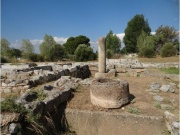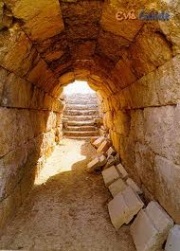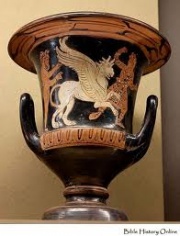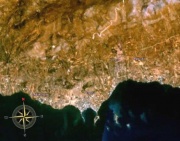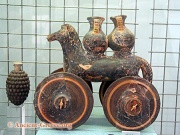Eretria
During much of the age of the great statesman Perikles (the later fifth century B.C.), Athens was embroiled in a long and bitter civil war. Weary of fighting, Athenians increasingly rejected the depictions of battle scenes on pottery in favor of peaceful motifs of heavenly gardens with young, playful divinities. Most popular was Aphrodite, goddess of love and beauty and the antithesis of war. Very common at this time were pyxides, small containers for perfume and cosmetics, whose use might transform the average Athenian housewife into the love goddess herself.
On the lid of this pyxis are depicted two pairs of playful Erotes, the companions of Aphrodite at play. One pair holds roosters in preparation for a fight, while the other displays a leashed rabbit (symbol of erotic love) to a potential lover. Around the cylindrical body are three vignettes of an aristocratic woman at leisure in her home with a maidservant in attendance. The so-called Eretria Painter was an accomplished artist whose interest centered on charming, intimate scenes, displaying the fashions and pastimes of the rich. These portrayals, replete with intriguing details of costume, hairstyle, and furnishings, represent an idealized stereotype of daily life for Athenian upper-class women who lived isolated at home.
The history of ancient Eretria from its founding to late antiquity will be the subject of an exhibition being launched 26 April at the National Archaeological Museum in Athens, Greece that aims to present a vivid and original view of the lives of the people there. The exhibition, titled "Eretria: A look at an ancient city," features 437 ancient artefacts. Seven Greek museums and the Italian Musei Capitolini are contributing to the show, which ends 26 August.
The exhibition will present Eretria's development over time, its public and private life, and the temples and burial grounds, as discovered from 1885 to today through excavations conducted in the western sector of the city, with the temple of Apollo Daphnephoros (Laurel Bearer). The Swiss Archaeological School has been working on the site since 1962.
The 437 ancient objects are separated into four sections:
The first section is devoted to the historical course of the city, which has been continuously inhabited from the beginning of the 3rd century BC.
The second section focuses on the daily life of the inhabitants, showing how after a period of decline around the 5th century BC, mainly resulting from the Persian wars, the city was rejuvenated and flourished during the 4th century BC.
The third section presents religious life - worship and temples and mainly the patron god, Apollo Daphnephoros.
The final section addresses the topics of death and the afterlife.
Don't miss this interesting exhibition at the National Archaeological Museum in Athens, Greece.
Lefkandi Heroon
The Heroon of Eretria was found in 1980.
It is oriented towards the East and it is about 90 meters long and 10 meters wide. The walls were made of stone and mud brick and the interior was plastered smooth. Postholes on the outside of the exterior walls, against the interior of the walls, and in the center indicate that timber was used to support the thatched roof. The Heroon has five interior rooms and a shallow porch.
The central room is the largest by far, and it contains two pits at its center. The north pit contained the skeletons of four horses, while the south pit contained the remains of a female who was buried among an impressive array of jewelry. Next to her a bronze crater was found that contained the cremated remains of a man aged 30-45. The couple was buried sometime in the 10th. C. BCE.
The heroon was later dismandled and an enormous tumulus of earth was created over it measuring 50 meters in length, 25 meters in width, and 4 meters in height. A shaft grave cemetery was created at a later time to the west of the Heroon.
Also:
http://en.wikipedia.org/wiki/Eretria
http://en.wikipedia.org/wiki/Eretria#History
http://www2.rgzm.de/Navis2/Home/HarbourFullTextOutput.cfm?HarbourNR=Eretria
